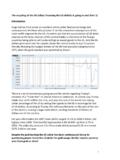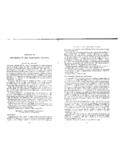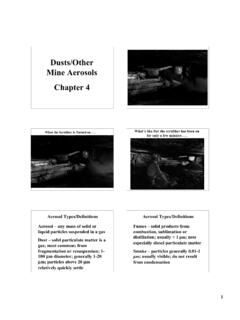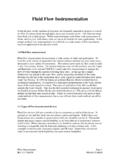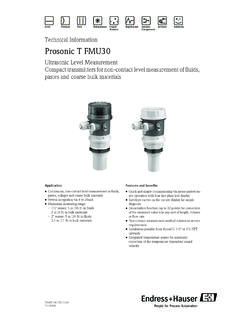Transcription of Basic Cyclone Design - ASME Met Section – …
1 Basic Cyclone DesignBill HeumannIntroduction Brief history What is a Cyclone ? A device that separates particulate from gas (fluid) by centrifugal force Works simply by the kinetic energy of the incoming mixture (flow stream) and the geometry of the cycloneHow Cyclones Work: NomenclatureOutlet Pipe/Vortex FinderHow cyclones work All cyclones work by centrifugalforce Two main factors affect Cyclone efficiency velocity particle moves towards the wall or collection area of the Cyclone where it is theoretically collected length of time available for collection: Residence Time Two main metrics describe Cyclone performance Pressure drop Fractional efficiency curve (FEC)How Cyclones Work: Basic Flow Patterns (Reverse Flow Cyclone )Another Kind of CycloneHow Cyclones Work.
2 Basic Flow/Pressure PatternsTangential VelocityAxial VelocityStatic PressureDifferent styles of Cyclones: Inlet Designs Different Arrangements of Cyclones Parallel ArrangementDifferent Arrangements of Cyclones: Series Arrangement Parallel CyclonesParallel CyclonesDifferent styles of cyclonic devices Parallel CyclonesReverse Flow-Axial InletSeries Cyclone ArrangementFCC Process: The heart of the systemFCC Regenerator CyclonesPressure Vessel CyclonesA Cyclone picture of another Use Cyclones? Dry No moving parts Robust Construction Can be easily designed for very severe duty (examples) Low cost (sometimes) SafetyWhen do you use a Cyclone ? When it is the most economical solution! Capital Costs Installation Costs Operating Expenses Maintenance Expense Depreciation (life expectancy) Safety and liability issue Product recovery System operability Effects on downstream equipment and processCyclone Performance Metrics: Pressure drop Pressure drop = power consumption Pressure drop measurement a inlet - a outletwhere; Cyclone pressure drop a = absolute pressureWhere Does Pressure Drop Come From?
3 Frictional and entrance losses usually = 10%-30% of total The rest is the pressure gradient generated by the vortexPressure drop @ no load Basic pressure drop equation ( Q2/Q1)E ( / 1)where;Q = gas flow rateE = geometry exponent ( ) = gas densityPressure drop @ load Pressure drop goes down with increased dust load Pressure drop dust loading equation L C 0C= ; L pressure drop @ load 0 pressure drop @ no loadW = dust load (grains/acf)Fractional efficiencies collection efficiency @ various particle sizes fractional or size efficiency curve may be graphical or tabularExample Size Efficiency CurveParticle Diameter (microns)% collection ( ) Variables Cyclone Geometry Cyclone Velocities Particle Density Gas Viscosity Dust LoadCyclone Total Collection Efficiency Function of the Cyclone FEC and incoming Particle Size Distribution (PSD) Cyclone Total Collection Efficiency can vary greatly but it may be doing exactly the same thing!
4 Total collection efficiency sample calculationparticlesize rangeparticle sizefractional efficiencies(microns)distributiond50coll ectioncollected particulateminmax(% by weight)(microns)(% by weight)(% by weight) Inlet configuration and ratio Cyclone L/D Ratio Outlet pipe penetration Dust receiver Residence timeTools for Increased Cyclone Efficiency: Cyclone Geometry VariablesTools for Increased Cyclone Efficiency:High Residence TimeHigh Capacity/Low Residence TimeHigh Residence Time/Low CapacityTools for Increased Cyclone Efficiency:Parallel Cyclone Arrangements One of best tools for getting higher collection efficiency: For a given power consumption and family of cyclones, splitting the flow into parallel streams allows the use of more efficient, smaller cyclones: Small Cyclones are more efficient than large ones.
5 Parallel arrangements may provide the best solution when headroom is limitedTools for Increased Cyclone Efficiency:Parallel Cyclone ArrangementsTools for Increased Cyclone Efficiency:Series Cyclone Arrangements Can provide higher collection efficiency for a limited inlet velocity because of the cumulative efficiency: 90% @ 5 micron + 90% @ 5 micron= 99% @ 5 micron May provide for redundancy in the event of system upsetsVELOCITY VS. DISTANCE (METERS)TANGENTIALVELOCITY (M/S)CENTRIFUGALFORCE (G'S)Tools for Increased Cyclone Efficiency:Tangential (Radial) VelocityFc= m Vt2/r How do we increase Tangential velocity ? Increase Inlet velocity Increase Outlet velocity What else can we do to increase Centrifugal Force? Smaller radius flow path: Use parallel cyclones Decrease outlet pipe diameterTools for Increased Cyclone Efficiency: Tangential velocity and/or Centrifugal ForceOther Tools for Increased Efficiency: Geometry L/D Ratio Inlet Design Optimum Outlet Pipe Length Dust ReceiversOther Tools for Increased Efficiency: Arrangement Cyclones in Parallel Takes advantage of rule that says for cyclones of the same family (geometrically proportional) at the same operating conditions, smaller cyclones are more efficient than larger ones Cyclones in Series Redundant chances for particle collectionThe Costs of Increased Efficiency.
6 High Residence Time Cyclones Capital Cost Headroom May not be possible or viable with some processes Capital Costs Manifolding can be expensive and difficult Pneumatic isolation can be difficult or cost prohibitive More horizontal space requiredThe Costs of Increased Efficiency: Parallel Cyclones Capital Costs Manifolding can be expensive and difficult More horizontal space required Pressure Drop is Cumulative Diminished benefit as PSD gets smallerThe Costs of Increased Efficiency: Series Cyclones Pressure Drop (Power Consumption) Erosion Particle Attrition Re-entrainment At very high velocities may have acoustical and/or Ranque-Hilsch effectsThe Costs of Increased Efficiency: Increased VelocityHow Cyclones Fail Improperly Designed Incorrect or inaccurate Design data Lack of know how by Cyclone designer- after all, anyone can build a Cyclone Leakage into the Cyclone Plugged cyclones Cyclones wear out too quicklyHow Cyclones Fail: Design / Fabrication Errors No dust receiver Short outlet pipes Dished heads Poor or non existent airlocks Instruments or access ports installed into cyclonic flow streams Related equipment not designed for cyclonic flow Inlet elbows, transitions, or other obstructions For More Information Visit Contact:Bill Heumann4898 Brownsboro Road, Suite 300 Louisville, KY 40207PH.



